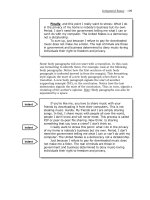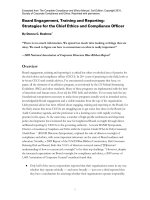Recruitment and Retention - Lessons for the New Orleans Police Department docx
Bạn đang xem bản rút gọn của tài liệu. Xem và tải ngay bản đầy đủ của tài liệu tại đây (330.71 KB, 49 trang )
This document and trademark(s) contained herein are protected by law
as indicated in a notice appearing later in this work. This electronic
representation of RAND intellectual property is provided for non-
commercial use only. Permission is required from RAND to reproduce, or
reuse in another form, any of our research documents.
Limited Electronic Distribution Rights
Visit RAND at www.rand.org
Explore RAND Gulf States Policy Institute
View document details
For More Information
This PDF document was made available
from www.rand.org as a public service of
the RAND Corporation.
6
Jump down to document
THE ARTS
CHILD POLICY
CIVIL JUSTICE
EDUCATION
ENERGY AND ENVIRONMENT
HEALTH AND HEALTH CARE
INTERNATIONAL AFFAIRS
NATIONAL SECURITY
POPULATION AND AGING
PUBLIC SAFETY
SCIENCE AND TECHNOLOGY
SUBSTANCE ABUSE
TERRORISM AND
HOMELAND SECURITY
TRANSPORTATION AND
INFRASTRUCTURE
WORKFORCE AND WORKPLACE
The RAND Corporation is a nonprofit
research organization providing
objective analysis and effective
solutions that address the challenges
facing the public and private sectors
around the world.
Purchase this document
Browse Books & Publications
Make a charitable contribution
Support RAND
This product is part of the RAND Corporation monograph series.
RAND monographs present major research findings that address the
challenges facing the public and private sectors. All RAND mono-
graphs undergo rigorous peer review to ensure high standards for
research quality and objectivity.
Bernard D. Rostker, William M. Hix, Jeremy M. Wilson
Recruitment and
Retention
Lessons for the New Orleans
Police Department
The RAND Corporation is a nonprofit research organization providing
objective analysis and effective solutions that address the challenges
facing the public and private sectors around the world. RAND’s
publications do not necessarily reflect the opinions of its research clients
and sponsors.
R
®
is a registered trademark.
© Copyright 2007 RAND Corporation
All rights reserved. No part of this book may be reproduced in any
form by any electronic or mechanical means (including photocopying,
recording, or information storage and retrieval) without permission in
writing from RAND.
Published 2007 by the RAND Corporation
1776 Main Street, P.O. Box 2138, Santa Monica, CA 90407-2138
1200 South Hayes Street, Arlington, VA 22202-5050
4570 Fifth Avenue, Suite 600, Pittsburgh, PA 15213-2665
RAND URL: />To order RAND documents or to obtain additional information, contact
Distribution Services: Telephone: (310) 451-7002;
Fax: (310) 451-6915; Email:
e study was performed as part of the RAND Corporation’s con-
tinuing program of self-initiated research. Support for such research is
provided, in part, by donors and by the independent research and devel-
opment provisions of RAND’s contracts for the operation of its federally
funded research and development centers. e research was conducted in
the Safety and Justice Program within RAND Infrastructure, Safety, and
Environment division.
Library of Congress Cataloging-in-Publication Data
Rostker, Bernard.
An analysis of recruiting and retention issues in the New Orleans Police
Department / Bernard D. Rostker, William M. Hix, Jeremy Wilson.
p. cm.
Includes bibliographical references.
ISBN 978-0-8330-4142-5 (pbk. : alk. paper)
1. Police—Recruiting—Louisiana—New Orleans. 2. Employee retention—
Louisiana—New Orleans. 3. Police administration—Louisiana—New Orleans.
4. New Orleans (La.). Police Dept. I. Hix, William M. (William Michael), 1940–
II. Wilson, Jeremy M., 1974– III. Title.
HV8148.N42.R67 2007
363.2'2—dc22
2007004907
iii
Preface
Hurricane Katrina and its consequent persistent flooding largely dis-
abled the New Orleans Police Department (NOPD) and other first
responders in the city. e police, fire, and emergency medical services
(EMS) organizations were engulfed themselves, becoming as much
victims of the storm as the people of New Orleans whom they were
responsible for helping. Since the hurricane, the NOPD has suffered
from unusually high rates of departure from the force and an inability
to recruit new officers.
e Superintendent of Police of the City of New Orleans asked
the RAND Corporation for help in addressing the recruiting and reten-
tion problems facing his department and for any suggestions on how
to improve the current situation. RAND agreed to try to help and to
apply insights gained from decades of working with large governmen-
tal organizations on ways to improve the management of their person-
nel systems, most extensively with the U.S. Department of Defense,
but more recently with the Federal Bureau of Investigation (FBI) and
several municipal police departments. Initial results, consisting of
practical suggestions for change that should help the NOPD improve
recruiting and retention, were briefed to the Superintendent and, at
his request, to the Mayor of New Orleans and members of the City
Council. is report expands upon the briefings and provides a more
detailed treatment of the recommendations presented to these senior
officials. e topics covered in this report and the specific recommen-
dations presented are based upon the unique situation in which the
NOPD found itself at the end of 2006. Specifically, the issues addressed
iv Recruitment and Retention: Lessons for the New Orleans Police Department
include the lack of affordable post-Katrina housing, the fact that the
families of many police officers no longer live in the New Orleans area,
the destroyed departmental infrastructure, and a budget that did not
provide enough resources to meet basic needs for even such things as
copying paper. While these issues are generally important for many
police departments, the recommendations presented here have been
tailored to the unique circumstances of the NOPD.
e study was performed as part of the RAND Corporation’s
continuing program of self-initiated research. Support for such research
is provided, in part, by donors and by the independent research and
development provisions of RAND’s contracts for the operation of its
federally funded research and development centers (FFRDCs). e
research was conducted in the Safety and Justice Program within
RAND Infrastructure, Safety, and Environment division. e mission
of RAND Infrastructure, Safety, and Environment is to improve the
development, operation, use, and protection of society’s essential man-
made and natural assets and to enhance the related social assets of
safety and security of individuals in transit and in their workplaces and
community. e Safety and Justice Program addresses occupational
safety, transportation safety, food safety, and public safety—including
violence, policing, corrections, substance abuse, and public integrity.
e project is also part of the RAND Center on Quality Policing,
which conducts research and analysis to improve contemporary police
practice and policy.
Questions or comments about this report or the Center on
Quality Policing should be sent to Jeremy Wilson (Jeremy_Wilson@
rand.org). Information about the Safety and Justice Program is avail-
able online (www.rand.org/ise/safety), as is information about the
Center on Quality Policing ( />policing/). Inquiries about research projects in the program should be
made to its director, Andrew Morral ().
Preface v
The RAND Gulf States Policy Institute
e RAND Gulf States Policy Institute (RGSPI) is a collaboration
among RAND and seven universities (Jackson State University, Tulane
University, Tuskegee University, University of New Orleans, Univer-
sity of South Alabama, University of Southern Mississippi, and Xavier
University) to develop a long-term vision and strategy to help build
a better future for Louisiana, Mississippi, and Alabama in the wake
of Hurricanes Katrina and Rita. e RGSPI’s mission is to support a
safer, more equitable, and more prosperous future for the Gulf States
region by providing officials from the government, nonprofit organiza-
tions, and the private sector with relevant policy analysis of the highest
caliber.
RGSPI is housed at the RAND Corporation, an international
nonprofit research organization with a reputation for rigorous and
objective analysis and effective solutions.
For additional information about the RAND Gulf States Policy
Institute, contact its director:
George Penick
RAND Gulf States Policy Institute
P.O. Box 3788
Jackson, MS 39207
601-797-2499
For a profile of RGSPI, see
More information about RAND is available at http:/www.rand.org.
Contents
vii
Preface iii
Tables
ix
Acknowledgments
xi
CHAPTER ONE
Introduction: e Problem 1
A Personal and Professional Disaster for the New Orleans Police
Department and Other First Responders
2
Recruiting and Retention Since Katrina
5
CHAPTER TWO
Lessons at Might Help the New Orleans Police Department 9
Compensation
11
NOPD Salaries Are Not Competitive
11
No-Cost Management Actions Can Also Improve Retention
16
e NOPD’s Retirement Plan
17
Housing as a Component of Compensation
18
Career Progression and Promotion
21
Recruiting
23
Civilian/Officer Mix
27
Morale
28
CHAPTER THREE
Conclusion 29
Bibliography
33
Tables
ix
1.1. NOPD Police Officer Strengths Pre- and Post-Katrina 5
2.1. New Orleans and Houston Police Department Salary
Comparisons
12
2.2. Compensation for a Married Army Sergeant with More an
Four Years of Service
14
3.1. Cost and Immediacy of Effect of Recommended Initiatives
30
xi
Acknowledgments
e NOPD provided support, cooperation, and openness almost
unprecedented in the RAND study team’s many years of research. In
particular, we wish to thank Superintendent Warren J. Riley, not only
for the time he spent with us, but even more for setting the tone of
complete cooperation at all levels of his department.
A remarkably knowledgeable and organized lieutenant, Julie
Wilson, served as our principal liaison with the NOPD. Julie made and
revised a seemingly endless series of interviews, meetings, and visits
with members of the department, often on very short notice. She per-
formed these tasks with unfailing efficiency and good humor. Without
her expertise, this project could not have been completed in the time
allotted. We are greatly indebted to her.
Space does not permit the naming of every official who cooper-
ated, but we wish to thank the following persons who contributed most
significantly: Courtney B. Bagneris, John Bryson, Raymond Burkart,
Louis Colin, Marlon Defillo, Greg B. Elder, Michael Glasser, Steph-
anie M. Landry, Stephen B. Nicholas, James Scott, Brad Tollefson,
Andrew Washington, and Mark Willow.
We wish to thank Bob Stellingworth, President and CEO of the
New Orleans Police and Justice Foundation, and Jeremiah Goulka of
the Federal Emergency Management Agency (FEMA) for generously
giving of their time to educate us on challenges facing the department
and potential solutions. Finally, we benefited from the constructive
comments of our RAND colleagues Frank Camm and Jerry Sollinger,
and our reviewers, James Hosek of RAND and Professor Edward
Maguire of George Mason University.
1
CHAPTER ONE
Introduction: The Problem
To appreciate the recruiting and retention challenges facing the New
Orleans Police Department (NOPD), it is necessary to understand the
unusual nature of Hurricane Katrina and how it affected and contin-
ues to affect the conditions under which NOPD officers work, as well
as the implications for their families and their personal lives.
More than a year after Hurricane Katrina devastated large por-
tions of the City of New Orleans, the NOPD continues to feel the
consequences of the storm. Unusually large numbers of police officers
have left the department, and few new officers have been recruited to
replace them. In one effort to address the twin problems of recruit-
ing and retention of officers, the Superintendent of Police asked the
RAND Corporation to undertake a “quick-look study” of the prob-
lems and to provide recommendations for solving them. e recom-
mendations presented in this report are based on our limited exposure
to the NOPD, along with insights gathered from extensive work with
large governmental organizations (including police departments) over
many years.
e report is organized into three chapters. e first discusses
the current problems facing the NOPD. e second presents recom-
mendations in five areas: compensation, including housing; the pro-
motion process and the career management system; recruiting; the
mix of officers and civilians; and ways to improve the morale of the
NOPD. e final chapter summarizes our conclusions and presents
recommendations.
2 Recruitment and Retention: Lessons for the New Orleans Police Department
A Personal and Professional Disaster for the New Orleans
Police Department and Other First Responders
e vast extent of the devastation Hurricane Katrina visited in par-
ticular on the City of New Orleans has been amply documented both
in the press and in books.
1
What is less commonly understood is the
extent to which the storm and its consequent persistent flooding dis-
abled the NOPD and other first responders in the city. e police, fire,
and emergency medical services (EMS) organizations were engulfed
themselves, becoming as much victims of the storm as were the citi-
zens they serve. Along the Mississippi coast that bore the full force of
the eye wall of Katrina, the water receded after the flood surge passed.
In New Orleans, however, the water did not recede. Once the levees
broke and the bowl that is New Orleans filled with water, large por-
tions of the city remained under water for weeks until the levees could
be repaired and the water pumped out.
For the men and women of the NOPD, the storm and its after-
math became both a personal and a professional tragedy. At a personal
level, most officers suffered the same displacement of families and loss
of property that other citizens suffered. e rising waters engulfed their
homes and their families.
2
As Katrina approached, most NOPD offi-
cers, following established procedures, reported to their district head-
quarters, ready for 12-hour shifts. Police cruisers and other emergency
vehicles, including special vehicles for rescuing people from high water,
were ready, as they had been for many storms before. What no one
was ready for was a breakdown in the levee system that protected the
city. Many police units found themselves isolated, without the ability
to respond or communicate. Police headquarters and three of eight
district headquarters were under water. e overwhelming majority of
officers put their duty to the citizens of New Orleans ahead of their
responsibilities to their families, contrary to much that has been writ-
ten about officers who abandoned their posts.
1
For example, see Douglas Brinkley, e Great Deluge: Hurricane Katrina, New Orleans, and
the Mississippi Gulf Coast, New York: William Morrow & Company, 2006.
2
Only 25 percent of the population of New Orleans escaped being flooded (Kevin F. McCar-
thy, D. J. Peterson, Narayan Sastry, and Michael Pollard, e Repopulation of New Orleans
After Hurricane Katrina, Santa Monica, CA: RAND Corporation, TR-369-RC, 2006).
Introduction: The Problem 3
Too little has been written about those who stayed and served
under enormously stressful, even primitive, conditions. Primary com-
munications were down. Most police vehicles were under water. Like
the rest of the citizens, many of the police lacked the basics of life:
food, clean water, and facilities for personal sanitation.
For many of the citizens of New Orleans, the aftermath of the
storm was almost as tragic as the storm itself.
3
About 55 percent of
the inhabitants experienced more than four feet of flooding, and their
housing suffered severe damage. Today, in some areas of the city, only
those who have been able to get trailers from the Federal Emergency
Management Agency (FEMA) have been able to return. In many areas,
in block after block, each house is marked with a yellow X on the front
door, along with the initials of the rescue team that surveyed the house,
when the survey was done, and how many bodies were found there.
Garage doors are still askew, knocked off their tracks by the rising
water. One can look from the front of the houses all the way through to
the back yard, since all the wallboard has been removed to control the
growth of mold. Unfortunately, the NOPD, collectively as an institu-
tion and individually as its officers, shares this situation.
At this writing, officers assigned to three of eight police districts
and to the police headquarters itself still work out of trailers. e head-
quarters and district buildings that flooded have not been repaired,
and officials could provide no estimates of when these buildings will
be restored to service. Officers lack the basic essentials to do their job.
e infrastructure that took years to develop is gone.
Since Katrina, demands on the resources of the city have grown,
while budgets have shrunk. Between 2005 and 2006, the funds avail-
able to the NOPD were cut by $18 million, from $124 million to $106
million, reflecting the overall financial problems facing the city. Every-
thing from toilet paper to copying paper seems to be in short supply.
Private organizations must raise money to provide some of the basic
supplies needed to do their jobs. In one instance reported to the RAND
3
e population of New Orleans, estimated at 485,000 for the year 2000, was “reduced to
fewer than several thousand by the end of the first week of September 2005” (McCarthy et
al., 2006).
4 Recruitment and Retention: Lessons for the New Orleans Police Department
team, a neighborhood association held a bake sale to buy copier paper
for a police district. e financial condition of the city and the NOPD
presented a practical constraint as RAND went about its work. It was
made very clear that to be most useful, the RAND team needed to
focus on low-cost solutions to problems, since the City of New Orleans
did not have much money to give to the NOPD.
Just as citizens wonder how they will rebuild, police officers
wonder when they will work again out of a functioning headquarters
or district office. Almost every police officer we interviewed at all ranks
throughout the department expressed frustration at this situation. e
barely functioning justice system has limited ability to hold suspects for
hearings or in detention, another source of frustration for the police.
4
It is often a race to see who gets back to the district first from central
booking, the booking officer or the suspect just booked. Of great con-
cern to the mayor and senior officials of the NOPD, as it must be to the
citizens of the city, is the increase in crime that has occurred even as the
population has dropped, and even after the NOPD received assistance
from the Louisiana State Police and the National Guard.
5
While the
population of the city is substantially smaller than it was before the
storm, after the initial dislocation and a lull in lawlessness, community
violence increased as residents returned to New Orleans and the crimi-
nal elements began fighting among themselves to establish new areas
of control. As reported in USA Today, “e murder rate [in June 2006
was] slightly below 2004, when New Orleans ranked No. 2 in the USA
after Camden, N.J., for per-capita murders.”
6
Peter Scharf, a criminolo-
gist at the University of New Orleans, calls the current situation a “per-
fect storm. You have a disabled criminal justice system because of the
flood. You’re also in fiscal crisis colliding with an epidemic of return-
4
For example, see Gwen Filosa, “Anti-Crime Officials Discuss Rise in Violence, Judge: City
Financing for Justice Falls Short,” e Times-Picayune, November 6, 2006.
5
Discussions with the Superintendent of Police, the Mayor, and members of the City Coun-
cil, September and October 2006. In addition, the U.S. attorney in New Orleans recently
told a conference on rebuilding New Orleans’ criminal justice system that “New Orleans
won’t recover from the storm unless it reduces violent crime.”
6
Alan Levin, “New Orleans Sees Its Worst Violence Since Before Katrina,” USA Today, June
19, 2006.
Introduction: The Problem 5
ing criminals.”
7
Under these conditions of limited financial resources,
destroyed infrastructure, and increasing crime, the NOPD finds itself
with an unprecedented personnel challenge.
Recruiting and Retention Since Katrina
e NOPD is shrinking. Table 1.1 shows that in the first 14 months
after Katrina, the budgeted commissioned police force was cut from
1,885 to 1,600, about 15 percent, reflecting the overall budget cuts to
the department and the department’s estimated recruiting and reten-
tion difficulties. During the same period, the actual on-board strength
declined by 321 officers, more than 18 percent, again reflecting unusu-
ally high losses and an inability to recruit after the storm.
8
Table 1.1
NOPD Police Officer Strengths Pre- and Post-Katrina
Number of Officers
Budgeted Actual
August 2005 1,885 1,742
October 2006 1,600 1,421
Change
Number –285 –321
Percent –15.1 –18.4
SOURCE: Stephanie M. Landry, NOPD. Data for 2005 are as of August 21, 2005; data
for 2006 are as of October 24, 2006.
7
Peter Scharf, “It’s a Perfect Storm: Comments by Peter Scharf,” New Hour Transcript: Crime
Increases in New Orleans as the City Recovers from Hurricane Katrina, Public Broadcasting
System, June 26, 2006.
8
According to e Times-Picayune, the pre-Katrina population was about 460,000, and the
current population is estimated at between 181,000 and 230,000, or between 40 and 50
percent of the base. ere were 3.78 police per 100,000 population before the storm and
between 7.8 and 6.2 after the storm. Nevertheless, the murder rate is reported to be “at the
top of the national murder rate list” (Brendan McCarthy and Laura Maggi, “Killings Bring
the City to Its Bloodied Knees: Husband, Wife Just Two of Six Shot in 24 Hours,” e
Times-Picayune, January 5, 2007).
6 Recruitment and Retention: Lessons for the New Orleans Police Department
e on-board strength during any period changes by the differ-
ence between new officers hired and existing officers who depart. Since
Katrina, officers have left at a much greater rate than that at which
the department has been able to hire new ones. Between August 2005
and January 2006, the NOPD lost 160 officers (40 per month) while
recruiting none.
9
During the first 10 months of 2006, the department
lost another 185 officers (18.5 per month). It has been able to recruit
33, who were scheduled to begin their training with the first post-
Katrina academy class on November 27, 2006,
10
but staffing continues
to decline at a significant rate.
Since the storm, the NOPD has experienced an annualized
loss rate of approximately 16.9 percent (345 of 1,742 officers lost over
14 months), compared with a 2005 pre-storm rate of 5 percent (57 of
1,695 officers lost in the first 8 months of 2005). e pre-storm rate
exactly equaled loss rates reported for large police departments serving
cities with populations of 50,000 or more.
11
Katrina destroyed much of the data necessary to perform a pre-
cise analysis of the demographics of losses. Data that are still available
indicate only that losses were concentrated disproportionately among
the junior ranks.
12
In other words, the NOPD was hemorrhaging the
very officers who patrol the streets today and were being counted on
9
is was the loss rate immediately following the storm. Before the storm, the loss rate was
7 to 8 per month (Stephanie M. Landry, NOPD).
10
Ibid.
11
Data are from a nationally representative sample of police agencies in 2000 reported in
Christopher S. Koper, Edward R. Maguire, and Gretchen E. Moore, Hiring and Retention
Issues in Police Agencies: Readings on the Determinants of Police Strength, Hiring and Retention
of Officers, and the Federal COPS Program, Washington, DC: e Urban Institute, 2001.
12
Preliminary data provided to RAND by the NOPD indicated a loss rate of 11.3 percent
among basic police officers (grades PO1 through PO4), 6.1 percent among sergeants, 7.5
percent among lieutenants, and 6.6 percent among captains. Half of all officers lost were in
the lowest grade (PO1), and 81 percent of them had less than five years of service. Compared
with nationally reported figures, the losses recorded by the NOPD were 22.5 percent greater
for officers serving in the first through fifth year, 35 percent greater for officers serving in
the sixth through fifteenth year, and 33 percent less for officers with more than 15 years of
service.
Introduction: The Problem 7
to provide the leadership for tomorrow. Given that officers with more
than 15 years of service have a limited number of years of future ser-
vice, because eligibility for retirement payments is a real incentive to
leave at some time in the not-too-distant future, it is the officers in the
middle grades upon whom the department must depend. It is trou-
bling that the officers from these years-of-service groups are leaving
at above-normal rates. e problem is exacerbated because more than
one year after the storm, the NOPD has yet to graduate its first post-
Katrina class at the police academy to replace these losses.
9
CHAPTER TWO
Lessons That Might Help the New Orleans Police
Department
is chapter addresses the recruiting and retention problems currently
faced by the NOPD and applies lessons that RAND has learned from
decades of working with large personnel organizations.
1
e chap-
1
Unlike small private firms that have very limited time horizons, large personnel systems
such as the military services, the Federal Bureau of Investigation (FBI), and major police
departments have indefinite time horizons. ese institutions are needed today and will be
needed in the future. Moreover, personnel decisions that are made today have both immedi-
ate results and long-term consequences. Generally, these institutions are “in-at-the-bottom,
up-through-ranks systems,” with limited programs for lateral entry. For example, Taylor et
al. report that 62 percent of large police departments (i.e., departments with more than 500
officers) allow lateral entry. For all departments, the number is somewhat lower: 50 percent
allow some lateral entry. Only 20 percent of state agencies allow lateral entry of officers
(Bruce Taylor, Bruce Kubu, Lorie Fridell, Carter Rees, Tom Jordon, and Jason Cheney, e
Cop Crunch: Identifying Strategies for Dealing with the Recruiting and Hiring Crisis in Law
Enforcement, Police Executive Research Forum, 2005). However, in 2003, the 22 police
agencies comparable in size to the NOPD reported a total of 43 lateral entries, with 16 (73
percent) reporting no lateral entries (U.S. Department of Justice, Bureau of Justice Statis-
tics, “Law Enforcement Management and Administrative Statistics (LEMAS): 2003 Sample
Survey of Law Enforcement Agencies,” Computer file, ICPSR04411-v1, Ann Arbor, MI:
Inter-University Consortium for Political and Social Research).
If it can maintain a steady flow of new recruits and have an even and predictable reten-
tion of officers, today and at any time in the future the force will have the age and experience
desired to ensure that it can do its job in the most cost-effective manner. e movement of
people through very large personnel systems such as the NOPD can be modeled as a Mar-
kovian process. In the early 1970s, RAND produced a series of papers and computer models
that provided both a theoretical and a computational underpinning for forecasting, plan-
ning, and policy simulation. In a 1971 report, John Merck and Kathleen Hall illustrated the
basic elements of a Markovian system by considering the flow of pilots and navigators over
time (J. W. Merck and Kathleen Hall, A Markovian Flow Model: e Analysis of Movement
10 Recruitment and Retention: Lessons for the New Orleans Police Department
ter covers five topics: compensation, including housing; the promo-
tion process and career management; recruiting; the mix of officers
and civilians; and ways to improve the morale of the NOPD. For each
topic, we discuss the problem facing the NOPD and the lessons RAND
has learned from previous studies and research and offer recommenda-
tions. Specific examples of previous studies and research are cited in
the footnotes; copies of these studies can be obtained from RAND.
e recommendations presented here have been effective in other con-
texts but must be tailored and fine-tuned to the specific circumstances
of New Orleans at the time they are implemented. e topics cov-
ered in this report and the specific recommendations reflect the unique
situation that the NOPD found itself in at the end of 2006—lacking
affordable post-Katrina housing, the families of many police officers
no longer living in the New Orleans area, the departmental infrastruc-
ture destroyed, and dealing with a budget that did not provide enough
resources to meet basic needs for even such things as copying paper.
While the issues addressed here are generally important for large police
departments, the recommendations have been tailored to the circum-
stances of the NOPD. Furthermore, any policy change or new pro-
gram must be closely monitored to ensure that it is having the desired
effect.
During August and September 2006, the RAND team visited
New Orleans to talk with members of the NOPD (from the super-
intendent down to PO1s) to gain a better understanding of the prob-
lems facing the department and to recommend solutions. From the
beginning, it was clear that given the current resources available and
the problems facing the city, any policy recommendations that would
require a substantial amount of money would have little chance of being
implemented. Decisions about public spending are often informed by
cost-benefit analysis, but today New Orleans has little ability to take
on substantial new costs, regardless of the benefits. e RAND team
therefore focused on useful initiatives that involve modest or no direct
budgetary cost to the city.
in Large-Scale (Military) Personnel Systems, Santa Monica, CA: RAND Corporation, R-514-
PR, 1971).
Lessons That Might Help the New Orleans Police Department 11
Compensation
Getting compensation right is critical. e mantra has been that com-
pensation is used to attract and retain personnel,
2
but compensation
also has an important role to play in motivating employees. e struc-
ture of the compensation is critical to an assessment or design of a
department’s compensation system.
3
Compensation affects an employ-
ee’s willingness to sign up, to stay, and to seek higher levels of responsi-
bility and promotion. Compensation includes direct dollar payments,
payment in-kind, and deferred compensation. Ideally, there is a cost-
effective mix of these elements that will maximize the return on the
money spent, in terms of ability to attract the right people, get them to
stay, and motivate them to higher levels of performance. Finding the
right mix, however, is difficult; it does not come about just by chance.
Based on previous RAND studies and an admittedly “quick
look” at the specific situation in New Orleans, the following subsec-
tions present comments and recommendations concerning the overall
level and competitiveness of the salaries offered by the NOPD, the mix
of current and deferred compensation, and the mix of cash and pay-
ments in-kind, specifically the use of housing as an incentive to join
and stay with the NOPD.
NOPD Salaries Are Not Competitive
In general, the competitiveness of the NOPD salaries should be judged
relative to outcomes such as hiring and retaining the quality and quan-
tity of personnel sought. To indicate how noncompetitive salaries may
be, Table 2.1 compares the salary structure of the NOPD with that of
the Houston, Texas, Police Department.
4
2
e emphasis on recruiting and retention is seen in Kenneth J. O’Brien, Recruiting and
Retention Best Practices Update, Sacramento, CA: California Commission on Peace Officer
Standards and Training, April 2006.
3
For example, see Beth J. Asch and John T. Warner’s classic work, A eory of Military Com-
pensation and Personnel Policy, Santa Monica, CA: RAND Corporation, MR-439-OSD,
1994.
4
As a follow-on to this study, RAND is undertaking a more complete analysis of the impact
that salary systems and recruiting and retention programs have on the ability of police









